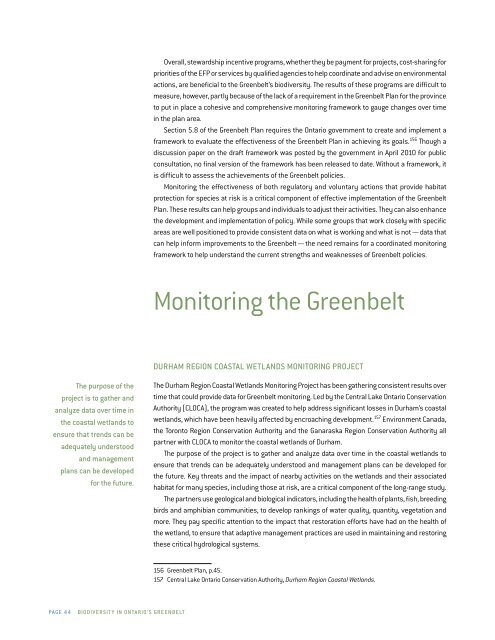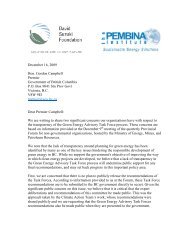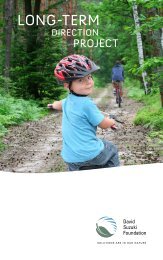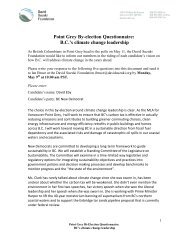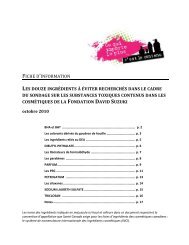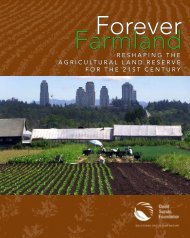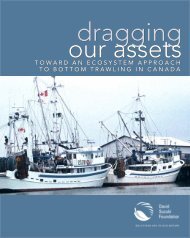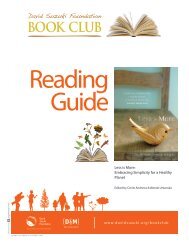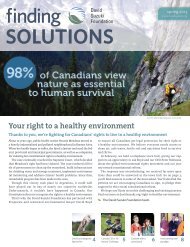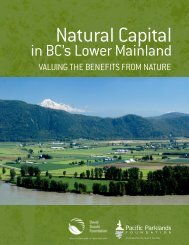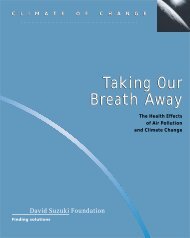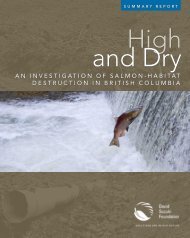Biodiversity in Ontario's Greenbelt (PDF) - David Suzuki Foundation
Biodiversity in Ontario's Greenbelt (PDF) - David Suzuki Foundation
Biodiversity in Ontario's Greenbelt (PDF) - David Suzuki Foundation
Create successful ePaper yourself
Turn your PDF publications into a flip-book with our unique Google optimized e-Paper software.
Overall, stewardship <strong>in</strong>centive programs, whether they be payment for projects, cost-shar<strong>in</strong>g for<br />
priorities of the EFP or services by qualified agencies to help coord<strong>in</strong>ate and advise on environmental<br />
actions, are beneficial to the <strong>Greenbelt</strong>’s biodiversity. The results of these programs are difficult to<br />
measure, however, partly because of the lack of a requirement <strong>in</strong> the <strong>Greenbelt</strong> Plan for the prov<strong>in</strong>ce<br />
to put <strong>in</strong> place a cohesive and comprehensive monitor<strong>in</strong>g framework to gauge changes over time<br />
<strong>in</strong> the plan area.<br />
Section 5.8 of the <strong>Greenbelt</strong> Plan requires the Ontario government to create and implement a<br />
framework to evaluate the effectiveness of the <strong>Greenbelt</strong> Plan <strong>in</strong> achiev<strong>in</strong>g its goals. 156 Though a<br />
discussion paper on the draft framework was posted by the government <strong>in</strong> April 2010 for public<br />
consultation, no f<strong>in</strong>al version of the framework has been released to date. Without a framework, it<br />
is difficult to assess the achievements of the <strong>Greenbelt</strong> policies.<br />
Monitor<strong>in</strong>g the effectiveness of both regulatory and voluntary actions that provide habitat<br />
protection for species at risk is a critical component of effective implementation of the <strong>Greenbelt</strong><br />
Plan. These results can help groups and <strong>in</strong>dividuals to adjust their activities. They can also enhance<br />
the development and implementation of policy. While some groups that work closely with specific<br />
areas are well positioned to provide consistent data on what is work<strong>in</strong>g and what is not — data that<br />
can help <strong>in</strong>form improvements to the <strong>Greenbelt</strong> — the need rema<strong>in</strong>s for a coord<strong>in</strong>ated monitor<strong>in</strong>g<br />
framework to help understand the current strengths and weaknesses of <strong>Greenbelt</strong> policies.<br />
Monitor<strong>in</strong>g the <strong>Greenbelt</strong><br />
Durham Region Coastal Wetlands Monitor<strong>in</strong>g Project<br />
The purpose of the<br />
project is to gather and<br />
analyze data over time <strong>in</strong><br />
the coastal wetlands to<br />
ensure that trends can be<br />
adequately understood<br />
and management<br />
plans can be developed<br />
for the future.<br />
The Durham Region Coastal Wetlands Monitor<strong>in</strong>g Project has been gather<strong>in</strong>g consistent results over<br />
time that could provide data for <strong>Greenbelt</strong> monitor<strong>in</strong>g. Led by the Central Lake Ontario Conservation<br />
Authority (CLOCA), the program was created to help address significant losses <strong>in</strong> Durham’s coastal<br />
wetlands, which have been heavily affected by encroach<strong>in</strong>g development. 157 Environment Canada,<br />
the Toronto Region Conservation Authority and the Ganaraska Region Conservation Authority all<br />
partner with CLOCA to monitor the coastal wetlands of Durham.<br />
The purpose of the project is to gather and analyze data over time <strong>in</strong> the coastal wetlands to<br />
ensure that trends can be adequately understood and management plans can be developed for<br />
the future. Key threats and the impact of nearby activities on the wetlands and their associated<br />
habitat for many species, <strong>in</strong>clud<strong>in</strong>g those at risk, are a critical component of the long-range study.<br />
The partners use geological and biological <strong>in</strong>dicators, <strong>in</strong>clud<strong>in</strong>g the health of plants, fish, breed<strong>in</strong>g<br />
birds and amphibian communities, to develop rank<strong>in</strong>gs of water quality, quantity, vegetation and<br />
more. They pay specific attention to the impact that restoration efforts have had on the health of<br />
the wetland, to ensure that adaptive management practices are used <strong>in</strong> ma<strong>in</strong>ta<strong>in</strong><strong>in</strong>g and restor<strong>in</strong>g<br />
these critical hydrological systems.<br />
156 <strong>Greenbelt</strong> Plan, p.45.<br />
157 Central Lake Ontario Conservation Authority, Durham Region Coastal Wetlands.<br />
Page 44<br />
<strong>Biodiversity</strong> <strong>in</strong> Ontario’s greenbelt


